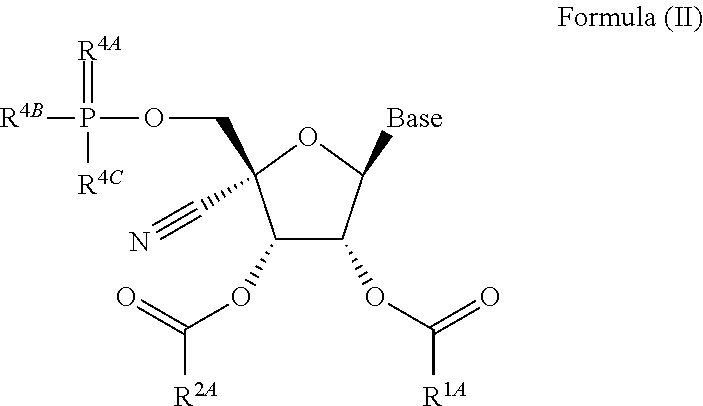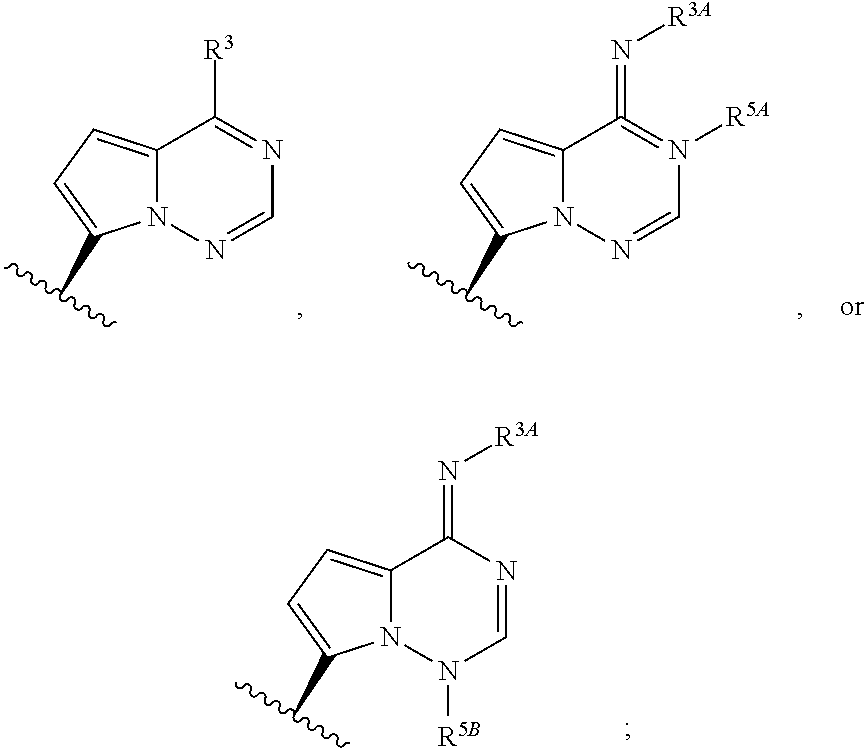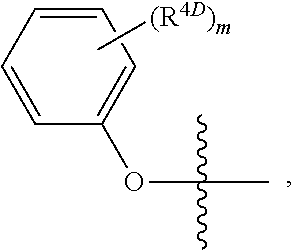Antiviral compounds
- Summary
- Abstract
- Description
- Claims
- Application Information
AI Technical Summary
Benefits of technology
Problems solved by technology
Method used
Image
Examples
example 1
opyl 2-(((S)-(((2R,3S,4R,5S)-5-(4-aminopyrrolo[2,1-f][1,2,4]triazin-7-yl)-2-cyano-3,4-dihydroxytetrahydrofuran-2-yl)methoxy)(phenoxy)phosphoryl)amino)propanoate
[0481]
[0482]Intermediate 1 (50 mg, 0.172 mmol) and Intermediate 18 (84 mg, 0.206 mmol) were mixed in anhydrous N,N-dimethylformamide (2 mL). Magnesium chloride (36 mg, 0.378 mmol) was added in one portion. The reaction mixture was heated at 50° C. N,N-Diisopropylethylamine (75 μL, 0.43 mmol) was added, and the reaction was stirred for 4.5 hrs at 50° C. The reaction mixture was cooled, diluted with ethyl acetate (30 mL) and washed with 5% aqueous citric acid solution (10 mL) and then brine (10 mL). The organic layer was dried over anhydrous sodium sulfate and concentrated under reduced pressure. The crude product was purified via SiO2 column chromatography (4 g SiO2 Combiflash HP Gold Column 0-2-5% methanol / dichloromethane) to afford the product. 1H NMR (400 MHz, Methanol-d4) δ 7.79 (s, 1H), 7.36-7.25 (m, 2H), 7.25-7.12 (m, 3H...
example 2
obutylmethyl 2-(((((2R,3S,4R,5S)-5-(4-aminopyrrolo[2,1-f][1,2,4]triazin-7-yl)-2-cyano-3,4-dihydroxytetrahydrofuran-2-yl)methoxy)(phenoxy)phosphoryl)amino)propanoate
[0483]
[0484]Intermediate 2 (50 mg, 0.116 mmol) and Intermediate 15 (60 mg, 0.139 mmol) were dissolved in anhydrous tetrahydrofuran (3 mL). Magnesium chloride (17 mg, 0.174 mmol) was added in one portion. Reaction was warmed to 60° C. and stirred for 20 min. N,N-Diisopropylethylamine (50 μL, 0.29 mmol) was added, and the reaction was stirred at 60° C. for 17 h. The reaction was cooled to room temperature, diluted with ethyl acetate (30 mL) and washed with 5% aqueous sodium carbonate solution (3×20 mL) and then brine (20 mL), dried over anhydrous sodium sulfate and concentrated under reduced pressure. Residue was dissolved in acetonitrile (2 mL) and stirred in an ice bath. 12 M hydrochloric acid (330 μL) was added dropwise and stirred for 20 h. The reaction was diluted with ethyl acetate (30 mL) and cooled in an ice bath. 1...
example 3
l 2-(((((2R,3S,4R,5S)-5-(4-aminopyrrolo[2,1-f][1,2,4]triazin-7-yl)-2-cyano-3,4-dihydroxytetrahydrofuran-2-yl)methoxy)(phenoxy)phosphoryl)amino)-3-phenylpropanoate
[0485]
[0486]To a mixture of Intermediate 4 (52.0 mg, 0.121 mmol), Intermediate 19 (68.0 mg, 0.145 mmol), and magnesium chloride (17.2 mg, 0.181 mmol) was added THF (1.0 mL) at RT. The resulting suspension was warmed to 50° C., and was allowed to stir for 10 min. N,N-Diisopropylethylamine (0.052 mL, 0.301 mmol) was then added and the resulting mixture was stirred at 50° C. for 30 min. The reaction mixture was then allowed to cool to RT, and concentrated aqueous hydrochloric acid solution (12 M, 0.200 mL, 2.4 mmol) was added. After 1 h, the reaction mixture was cooled in an ice bath and quenched with saturated aqueous sodium carbonate solution to pH=7. The crude mixture was purified by preparatory HPLC (Phenominex Gemini NX 10u C18 250×30 mm column, 40-100% acetonitrile / water gradient) to afford the product. LC / MS: tR=1.27 mi...
PUM
 Login to View More
Login to View More Abstract
Description
Claims
Application Information
 Login to View More
Login to View More - R&D
- Intellectual Property
- Life Sciences
- Materials
- Tech Scout
- Unparalleled Data Quality
- Higher Quality Content
- 60% Fewer Hallucinations
Browse by: Latest US Patents, China's latest patents, Technical Efficacy Thesaurus, Application Domain, Technology Topic, Popular Technical Reports.
© 2025 PatSnap. All rights reserved.Legal|Privacy policy|Modern Slavery Act Transparency Statement|Sitemap|About US| Contact US: help@patsnap.com



